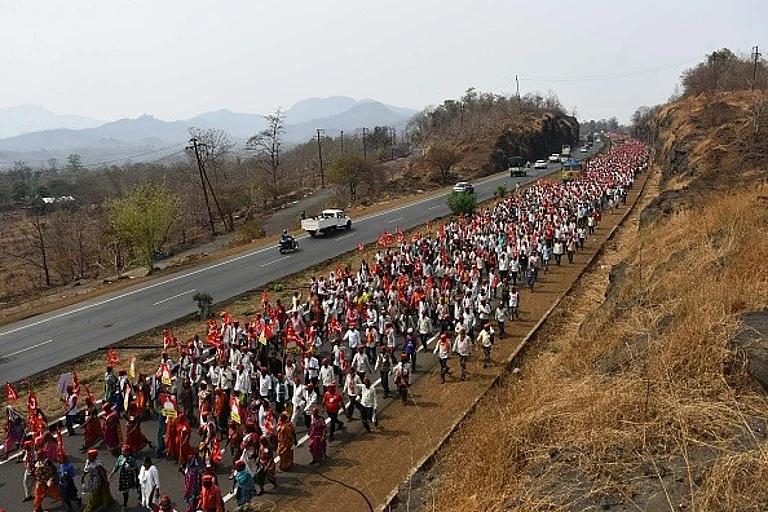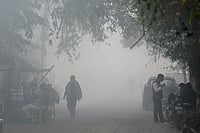Like hundreds of others at the Shambu border, a frail Hardev Singh has turned his tractor into a makeshift tent where he has been spending weeks since farmers started protesting on Feb 13. Hailing from Punjab’s Moga district, 75-year-old Singh has black flags tied to his red tractor — to rebel. A small-time farmer, he owns a three-acre plot where he has been working his whole life. His son has accompanied him for a few years but the shrinking rights of farmers today compels him to move to Canada like many of Punjab’s youth.
“We barely get any money for the produce procured from us. My son said he wants to go abroad because he will earn nothing by farming. We are the annadata, you get food at home because we grow it. Do we not deserve this minimum guarantee that we are asking? And then we are being called Khalistani,” he says.
When the government awarded the Bharat Ratna, the country’s highest civilian award, to agricultural titans like former Prime Minister Chaudhary Charan Singh and Dr MS Swaminathan, it made several headlines about the significance of honouring these key figures and their contributions. However, concerns were also raised about whether the honour actually had a deeper significance or was merely a political tactic to draw voters.
The Bharat Ratna came as thousands of farmers in Punjab renewed their protest seeking several demands, including a legal guarantee for a minimum support price (MSP) for crops based on the MS Swaminathan report. However, these demands remain a distant dream for the farmers while their legends are being given honorary statuses.
As the Opposition INDIA grouping framed its 2024 Lok Sabha poll battle around caste census, Prime Minister Narendra Modi said that for him, the four “biggest castes” that matter are the poor, the youth, women and farmers. Considering that farmers are one of these four “biggest castes”, one would expect that their demands are heard and promises made to them are kept.
Ahead of the budget in February 2016, Modi had said that his government would ensure that farmers’ income doubled by 2022. He reiterated this during the 2019 election campaign. However, after a decade under his leadership, the government has yet to fulfil this flagship promise. This year, under the PM Kisan Samman Nidhi programme, the government announced that it will double the direct cash transfer to landowning female farmers. But how many women farmers will benefit? Statistics have shown women are denied land rights even as nearly 80 per cent of them are involved in agricultural work.
On the other hand, while addressing a farmers’ convention held at Chandwad in Nashik, Rahul Gandhi outlined five big promises to farmers—MSP as per the Swaminathan Commission report, a permanent ‘Agriculture Loan Waiver Commission’, guarantee against crop loss, change in import-export policy and removal of GST from agricultural commodities—if the Congress is voted to power. Many of these promises have been made before but the party has failed to mobilise the farming community in the name of these promises.
According to the latest NCRB data, 11,290 farmer suicide cases were reported from across the country last year. This is equivalent to more than a death every hour.
A renewed farmers’ protest in Punjab has completed a month now. Their demands stem from a letdown by the government that promised a legal guarantee for MSP for crops. Their demands also include justice against the Lakhimpur Kheri incident where four protesting farmers and a journalist were mowed down by the SUV of Ashish Kumar Teni, son of Union Minister of State (MoS) Ajay Mishra Teni. However, Teni’s name was announced in the first list of BJP candidates for the Lok Sabha elections. He will be seeking re-election for the third consecutive term from Kheri in Uttar Pradesh.
In theory, farmers should have the most clout in India. The farming community has always been given great significance when it comes to poll promises and manifestoes. Ahead of any election, a slew of schemes are launched with promises of cash benefits, free electricity, ration and so on. However, for several decades, farming has remained a crisis and issues around financial security, land and crop damage still persist.
“Farming is at the rock bottom of the pyramid now,” says agricultural expert Devinder Sharma. “The biggest reason farmer issues get sidelined today is because there is a lack of union leaders standing up for them.”
Sharma says that a movement like the ongoing farmers’ protest in Punjab could have been the ideal event to make it a national issue and get the government to meet the demands. “But the farmer unions are so divided in themselves that the issues do not gain any momentum. Last time, it was their unity that got the farm laws repealed,” he says, referring to the 2021 farmers’ protest.
According to the 10th agricultural census (2015-16) (11th agricultural census was delayed due to Covid-19), small and marginal farmers with less than two hectares of land accounted for 86.2% of all farmers in India. However, they owned just 47.3% of the crop area. Further, the last Situation Assessment Survey for Agricultural Households, released by the National Sample Survey Office in 2021, showed that the average farm household income in India was Rs.10,218 a month. This is lower than the monthly wages of MGNREGA workers.
The data shows that Punjab, Haryana and Kerala still yield a higher monthly income—Rs 26,701, Rs 22,841 and Rs 17,915—among farming households, perhaps due to the impact of the 1980s ‘Green Revolution’ in the two northern states and a land reform movement in the 1950s in Kerala.
In contrast to that, farmers in Jharkhand have an average monthly income of Rs 4,895, in Odisha they have an income of Rs 5,112 and in West Bengal Rs 6,762. Even in an agrarian state like UP, farming households have a monthly income of a dismal Rs 8,061. Annually, the average annual income of farming households between 2015-16 and 2018-19 has increased from Rs 96,703 to Rs 1,22,616, a mere 2.8 per cent.
Among the issues raised by the protesting farmers is also a waiver of farm loans, something that the Indian government has allowed only twice since Independence. Half of the agricultural households in India (50.2 per cent as per 2019 NSSO survey) are in debt. While this number fluctuates, ground reports show us that it has barely improved. As a result, farmer suicides are on the rise.
According to the latest National Crime Records Bureau (NCRB) data released in 2023, 11,290 farmer suicide cases were reported from across the country last year. This is equivalent to more than a death every hour. The highest number of deaths was reported in Maharashtra, with the Vidharba region (1,439) being the hotspot of suicides, followed by Marathwada (1,088).
Opposition leaders and activists have linked these deaths to huge debts and crop failures with zero to minimal government support. Predominantly a cotton-farming region, farmers suffer a number of issues including the MSP debacle, lack of water rationing, irrigation struggles, increasing cost of inputs like seeds, fertilisers and pesticides, bad crop insurance policies, arm twisting by middlemen and weak leadership. Vijay Wadettiwar, the leader of the Opposition in the state, has also accused the Maharashtra government of being apathetic towards their struggles.
India is missing the presence of staunch farmer leaders. For a country with a history of farmer activism, led by the likes of Sahajanand Saraswati in Bihar, Baldev Ram Mirdha in Rajasthan, Charan Singh in Uttar Pradesh, to Mahendra Singh Tikait and Sharad Joshi, the current set of leaders is far from mobilising farmers at the ground level. The fleeting, often rhetorical, references to farmers and their struggles in party manifestos do not convert into votes to swing elections.
As a result, farmers end up choosing their leaders on the basis of grounds other than farming. Retired JNU professor and economist Arun Kumar says that farmers rarely cast their votes as farmers. “It is a question of multiple identities. The farmers are voting not simply as farmers but also as rich and poor, as Hindus and Jats, or as not Hindus and Jats. They are divided along different party lines and ideologies and are not thinking about themselves as farmers in crisis while voting,” he says.
MORE FROM THIS ISSUE
Another factor that diminishes farmer issues in polls, Kumar adds, is that the country lacks a strong Opposition. “Today, there is hardly any mobilisation against the ruling party. The opposition leaders are scared. They are being cowed down by ED, I-T and other agencies. They are divided. The ruling party has used state instrumentalities to weaken the opposition. They are threatening leaders, buying them out and toppling governments, left, right and centre.”
This becomes evident as, despite a series of farmers’ protests across the country over the past few years, in successive elections, the BJP has managed to trump the economic factors and any anti-government sentiment among farmers by using the socio-political landscape to garner emotional support. While the Assembly poll results last December have further buoyed their confidence, the grand inauguration of Ram Temple in Ayodhya further strengthened their vote base in the name of religion.
With nearly 65 per cent of India’s 1.4 billion people in rural areas and 54 per cent of households involved in agriculture, farmers are a crucial voting bloc for the ruling party as well as the Opposition in the upcoming elections. However, with farmers reeling under pressure year after year, will their vote have any impact on their situation?
(This appeared in the print as 'The Iron Harvest')
































